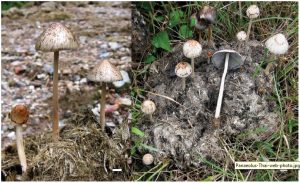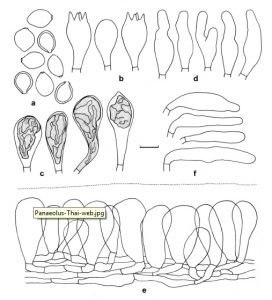Panaeolus antillarum (Fr.) Dennis, Kew Bull. 15(1): 124. 1961. Index Fungorum number: IF 335553
=Agaricus antillarum Fr., Elench. fung. (Griefswald) 1: 42. 1828.
= Psilocybe antillarum (Fr.) Sacc., Syll. fung. (Abellini) 5: 1052. 1887.
= Annelaria antillarum (Fr.) Hlaváček, Mykologický Sborník 74(2): 52. 1997.
Heterotypic synonyms: refer to Pegler (1977, 1983) and Halama et al. 2014.
Holotype :Antilles, St. Croix, coll. by P.E. Benzon (material lost).
Pileus 20–80 mm diam, obtusely conical, margin incurved to straight, radially rugulose to rugulose-striate; surface subviscid, glabrous, subhygrophanous when young, mottled and radially streaked; at first dark brown (7F5–8) with paler brown (7E5) or pale brownish grey (6C3) areas, soon disc, spots and radially streaked areas dark brown to brown and elsewhere becoming tan to beige or off-white, streaked and spotted in age; not becoming areolate or scaly. Context 3–5 mm thick, off-white, not staining where bruised. Lamellae narrowly adnexed, close to crowded with 4 series of lamellulae, broad (6–9 mm), pale greyish white (5–6B1), becoming dark grey to black, slightly mottled; lamellar edge white-pruinose; spore deposit black. Stipe 45–110 × 3–7 mm, central, ±terete, cylindrical above, gradually enlarged downward, striatulate above, smooth elsewhere, solid; surface dull, dry, minutely furfuraceous to granulose-pruinose, base with white tomentum; apex off-white, base pale greyish orange (5B3); partial veil absent. Tissues not cyanescent where bruised. Odor and taste mild, not distinctive.
Basidiospores 11.8–14.4 × 9.6–11.2 (face view) × 8.0–10.2 (profile) μm [xm = 13.4 ± 0.85 × 10.43 ± 0.59 (face view) × 8.97 ± 0.7 (profile) μm, Q = 1.14–1.37 and Qm = 1.29 ± 0.06 (face view), n = 25, s = 1], broadly limoniform in face view, asymmetrically ellipsoid in profile, with a broad central germ pore up to 3 μm diam, smooth, dark brown to nearly black, thick-walled (0.7–1.0 μm). Basidia 24–30 × 12.5–14.5 μm, broadly clavate, 4-spored, unclamped. Basidioles broadly clavate. Chrysocystidia 32–45 × 11–14 μm, clavate, seldom with a small papilla, with pale yellow, refractive, oily-glassy contents. Lamellar edge sterile. Cheilocystidia 28–38 × 6.5–12 μm, irregularly fusoid to irregularly ventricose, broadly obtuse, rarely bifid, hyaline, thin-walled. Pileipellis a hymeniform layer on the disc to an epithelium on the margin, of broadly clavate to ampullaceous or subglobose cells 32–48 × 14–34 μm, hyaline, inamyloid, thin-walled, overlaid with a gelatinous film up to 16 μm thick; arising from a subcutis of irregularly-shaped, often short-celled hyphae with diffuse, brown parietal pigments, non-gelatinous. Pileocystidia absent. Pileus trama interwoven; hyphae 5–20 μm diam, irregular in outline, inflated, hyaline, inamyloid, non-gelatinous, thin-walled. Stipitipellis an interrupted trichodermium of erect to repent caulocystidia; cortical hyphae 3.2–6.5 μm diam, cylindrical, hyaline, inamyloid, non-gelatinous, non-incrusted, thin-walled; medullary hyphae similar, up to 13 μm diam. Caulocystidia 28–48 × 6.5–9.5 μm, irregularly cylindrical to fusoid, broadly obtuse, hyaline, thin-walled. Clamp connections absent in all tissues.
Habit and known distribution : Gregarious, coprophilous, with stipe base buried in elephant dung. Thailand.
Material examined : THAILAND. Nakorn Nayok Province, Khao Yai National Park, Princess trail ca 2 km from Visitor’s Center, N14˚26.146′, E101˚23.080′, elev. 750 m, 7 July 2005, coll. by D.E. Desjardin, DED 7874 (MF497585, SFSU). DOMINICAN REPUBLIC. Santiago Province, Pedregal, on road from Los Montones Convention Center, on mule dung, 15 January 2003, coll. by Lance Lacey, LL 156 (MF497586, CORT 013830).
Notes : Panaeolus antillarum in Thailand is characterized by large basidiomes with the following features: an obtusely conical, brown and off-white, streaked and mottled pileus up to 80 mm diam, that typically does not become areolate or scaly at maturity; a long (up to 110 mm), solid, off-white stipe lacking a partial veil; broadly limoniform (face view) basidiospores 11.8–14.4 × 9.6–11.2 × 8.0–10.2 μm with mean 13.4 × 10.4 × 9 μm; abundant clavate chrysocystidia 11–14 μm diam; irregularly fusoid cheilocystidia; cylindrical caulocystidia; a hymeniform to epithelium-type pileipellis lacking pileocystidia overlaid with a gelatinous exudate; an absence of clamp connections; and growth on wild elephant dung.
FIGURE. Basidiomes of Panaeolus antillarum (DED 7874). Scale bars = 10 mm

FIGURE. Micromorphological features of Panaeolus antillarum (DED 7874). a. Basidiospores. b. Basidia and basidiole. c. Chrysocystidia. d. Cheilocystidia. e. Hymeniform pileipellis. Dotted line represents upper limit of gel layer. f. Caulocystidia. Scale bar = 10 μm

